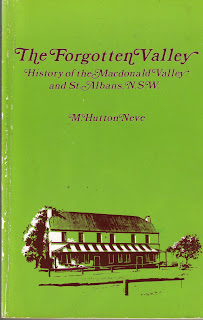The other day, a woman rang ABC local radio 702 in Sydney and said she lived in the Forgotten Valley. The announcer had never heard of it. The Macdonald Valley, she explained. But no, she didn't know how it got the name.
 Perhaps I can help. For years I've had this book, a history of the Macdonald Valley, and I believe the book's title may have been the first usage of the term Forgotten Valley – an apt title for the remote valley winding up into rugged sandstone gorges north of Wisemans Ferry, just a few hours from the heart of Sydney.
Perhaps I can help. For years I've had this book, a history of the Macdonald Valley, and I believe the book's title may have been the first usage of the term Forgotten Valley – an apt title for the remote valley winding up into rugged sandstone gorges north of Wisemans Ferry, just a few hours from the heart of Sydney.It was forgotten not only because of its remoteness, but also because the settlers who first moved away from the Hawkesbury River's flood-prone banks and up the Macdonald and the adjacent Webb's Creek were emancipists – convicts who'd received a conditional or full pardon – and it's probable they preferred to be forgotten.
Their world was that described in Kate Grenville's prize-winning The Secret River, a fiction novel loosely based on the life of Solomon Wiseman.
Many of them wanted no further contact with the administrators and soldiers and churchmen who enforced the penal system, and the fertile flats of the Lower Branch – or the First Branch, the commonly used early names for the Macdonald – gave them that refuge.
As the generations went by, the early settler families lived out their lives with minimal contact with the outside world.
I discovered the valley almost 40 years ago, when I'd moved to the Central Coast and began exploring the hinterland. In those days, in the township of St Albans, the Settlers Arms hotel, built in 1848, was closed, a store on the other side of the bridge sold grog and other necessities, medical needs were met by a bush nurse, and most of the small churches were derelict or little used.
Only a few miles to the east, one could walk or drive along the colony's greatest engineering work of the earlier 19th century – the Great North Road, built to the Hunter lands by chained gangs of convicts, but much of it seldom used because of the barren and isolated mountain ridges it traversed.
Travellers preferred the valley route through St Albans and Mogo Creek before rejoining the Great North Road near Mt Simpson for the final stages to Wollombi and beyond.
 The Settlers Arms thrived until the opening of the Pacific Highway to Newcastle in the 1930s diverted most traffic, and the valley went back to sleep. In 1939 the Settlers Arms's licence was transferred to the Aerodrome hotel at Clarendon near Richmond.
The Settlers Arms thrived until the opening of the Pacific Highway to Newcastle in the 1930s diverted most traffic, and the valley went back to sleep. In 1939 the Settlers Arms's licence was transferred to the Aerodrome hotel at Clarendon near Richmond.
Well before I wandered into the valley, a New Zealand-born Sydney journalist and local history enthusiast, Marjorie Hutton Neve, had spent years researching the Macdonald and its people. The result, The Forgotten Valley, is an impressive local history.
First published by the Library of Australian History in 1978 in a limited edition of 1000 copies, the book won acclaim for its understanding of seldom-researched areas of Australian social and settler history. A revised edition followed in 1982, and a soft cover reprint in 1987 (which is the book I have).
The reprint was dedicated to the memory of Mrs Hutton Neve, who died on 24 November 1987, aged 82.
Chapter One, headed “Inns and Graves and Ghosts”, begins:
Within three hours' motoring of Sydney is a wild and lovely valley of forgotten history, where pioneer settlers sleep in forlornly neglected small cemeteries, or whose headstones mark their resting places on the original land grants.
The Macdonald River meanders shallowly through farmlands and past a few scattered cottages; above tower the enclosing mountains bushclad and rock-strewn; over all there seems to emanate a strangely disturbing restlessness, as if the disembodied spirits of the first pioneers still exert an unseen influence in the once life-pulsating Valley.
the long-reopened Settlers Arms buzzes with Sunday trade, where expansive homes on hobby farms dominate the landscape, where drifts of sand obliterate the once fertile flats and the river is so silted one could not paddle a canoe within kilometres of the Bullock Wharf at St Albans, it is still possible to pause and feel the ghosts of history.
Even today, when
A recent search of ABE books turned up two Sydney dealers with first
edition copies of Forgotten Valley, priced at $41.40 and $45 plus postage.
Presumably cheaper copies of the revised edition turn up from time to time.

No comments:
Post a Comment